Email: conradt@ualberta.ca
Conrad is currently a Wildlife Biologist with the BC Government in Smithers, BC.
Dispersal and source-sink dynamics of gray wolves (Canis lupus) using non-invasive molecular genetic techniques in the Canadian Rocky Mountains.
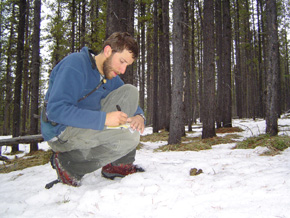 |
| Collecting wolf scat while snow tracking. |
Large carnivores such as wolves (Canis lupus) tend to be highly mobile both within their home ranges1,2 and during periods of dispersal and extraterritorial movements3,4. These movements are often through landscapes that vary in management objectives and attitudes towards wolves5. The role of mortality and the subsequent recolonization of areas is of key importance to population viability for wolves6. Currently little is known of the source-sink dynamics of wolves in the Canadian Rocky Mountains, however it has suggested that the National Parks in the study area may be acting as a sink for wolves rather than a source6. Dispersal directions and distances for general populations and for individuals can be derived from genetic data7,8 rather than traditional methods of radio or satellite tracking. The use of genetic methods to quantify dispersal patterns has proven to be a powerful and cost-effective tool. This study was designed to non-invasively examine degree of relatedness within and between wolf packs as well as determine parentage where possible in order to elucidate past movements of individuals between packs within and from outside protected areas in the study area. Movement patterns between packs were analysed to determine rates of immigration/emigration in order to identify source/sink dynamics between packs.
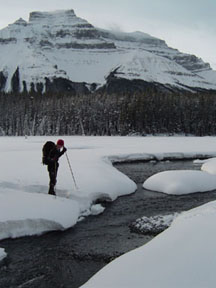 |
| Rebecca Rothgeb crossing North Saskatchewan River. |
Our objectives were: 1. To identify and catalogue extant individual wolves within the study area using non-invasive DNA sampling in conjunction with other sources where possible to determine the genetic structure of the population and minimum population size. We catalogued known wolf mortalities in the same region and relate this to source areas. 2. To determine degree of relatedness between wolves of different packs, and maternity and paternity for as many wolves sampled as possible to determine the origin of wolves. 3. To examine territories within the study area as potential sources or sinks and barriers to dispersal for colonising wolves.
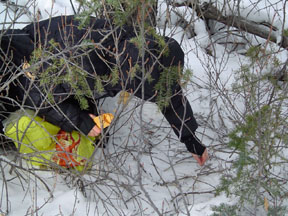 |
| Collecting hair from wolf bed-site. photo N.Debruyn |
The study focused on the Canadian Rocky Mountain Parks and surrounding non-parkland in Alberta and British Columbia, Canada. The area straddles the continental divide between Alberta and British Columbia, extending west to the Columbia River Trench and east to include the foothills of Alberta. The northern boundary of the study is north of the Jasper town site and southern limit is the southern tip of Banff National Park. We plan to incorporate inter-agency cooperation to include as many wolf packs in the region as possible.
Although much research with wolves has occurred within the Canadian Rocky Mountain national parks little work has been completed looking at wolf packs outside of the parks. To gain better understanding of wolf population dynamics within the area it is imperative that connections between park and non-park packs be examined. The project I outlined was intended to increase the base of knowledge of wolf dispersal patterns and relatedness of wolf packs within the study area including transboundary movements made by dispersing individuals.
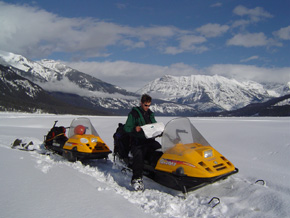 |
| Nathan Debruyn searching for tracks on Kinbasket Lake. photo R.Rothgeb |
The results are essential for cross-jurisdictional management and cooperation with regards to wolves which are large, wide ranging carnivores that use a diverse landscape with varying management objectives. Hunters and trappers that utilize wolves for recreational harvest and income will benefit from informed decision making by managers leading towards viable populations and a scientific basis for harvest regimes.
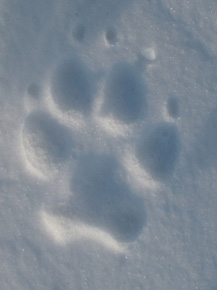 |
| Wolf track. photo R.Rothgeb |
The techniques that were used in the course of this study are relatively new and have not been used extensively with wolves. The testing of these methods provides strength to the general methodology that have profound effects on work with rare, elusive and/or cryptic species anywhere they may occur. The value of collaring wild animals will remain, however these new techniques revolutionize the way we approach many questions. The genetic information collected during the study can be used as baseline data for wolf studies of genetic diversity, genetic drift, and rates of inbreeding. Repeated sampling in the future will allow for interpack movements of individuals previously identified in this study to be identified and quantified using the same methodology.
LITERATURE CITED
1. Cook, S.J, Norris, D.R., Theberge, J.B. 1999. Can. J. Zool. 77:1740-1750. 2. Wabakken, P., Sand, H., Liberg, O., Bjärvall, A. 2001. Can. J. Zool. 79: 710-725. 3. Ballard, W.B., Farnell, R., Stephenson, R.O. 1983. Canadian Field-Naturalist 97: 333. 4. Boyd, D.K., Pletscher, D.H. 1999. J. Wildl. Manage. 63: 1094-1108. 5. Forbes, G.J. and Theberge, J.B. 1996. Conservation Biology 10: 1091-1097. 6. Callaghan, C.J. 2002. Ph.D. Thesis. University of Guelph, Guelph, Ontario. 7. Spong, G., Creel, S. (2001) Proc. R. Soc. Lond. B, 268, 2571-2574. 8. Girman, D.J., Mills, M.G.L., Geffen, E., Wayne, R.K. 1997. Behavioral Ecology and Sociobioogy, 40, 187-198. 9. Lucchini, V., Gabbri, E., Marucco, F., Ricci, S., Boitani, L., Randi, E. 2002. Molecular Ecology 11: 857-868. 10. Bernatchez, L. & Duchesne, P. 2000. Can. J. Fish Aquat. Sci. 57: 1-12. 11. Neff, B.D., Repka, J., Gross, M.R. 2000. Molecular Ecology 9: 529-539. 12. Wilson, A.J., Ferguson, M.M. 2002. Can. J. Fish. Aquat. Sci. 59: 1696-1707. 13. Taylor, B.L., Chivers, S.J., Sexton, S., Dizon, A.E. 2000. Conservation Biology 14: 1287-1297. 14. Waser, P.M., Strobeck, C. 1998. Trends in Ecology and Evolution 13: 43-44. 15. Boughton DA. 1999. Ecology, 80, 2727-2739.

